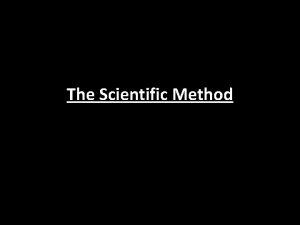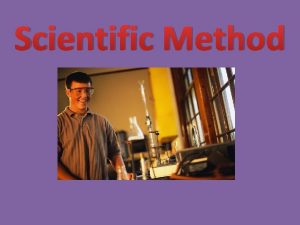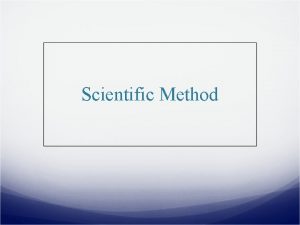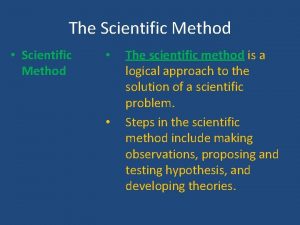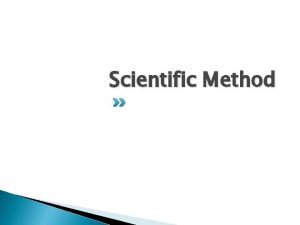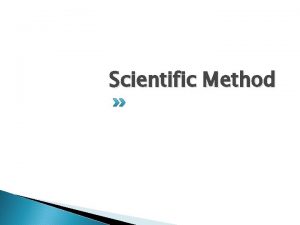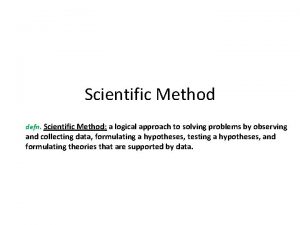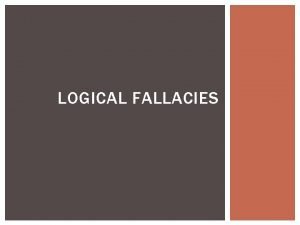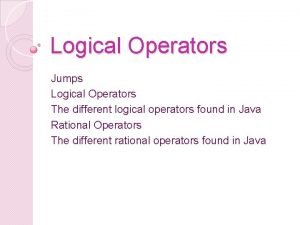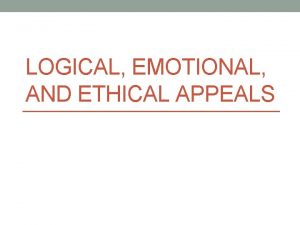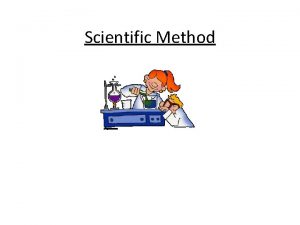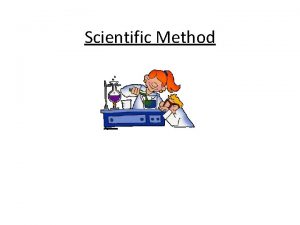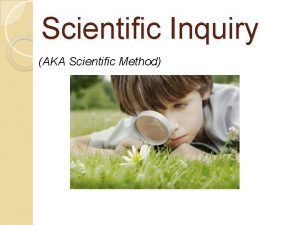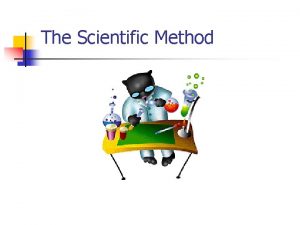The Scientific Method The Scientific Method a logical

































- Slides: 33

The Scientific Method

The Scientific Method �a logical, systematic approach to the solution of scientific problems � Observation – the use of your senses to obtain information � Hypothesis – proposed explanation for an observation � Experiment – procedure that is used to test a hypothesis � Manipulated variable – the variable you change � Responding variable – the variable that is observed � Theory – a well-tested explanation for a broad set of observations � Scientific Law – a concise statement that summarized the results of many observations and experiments

Scientific Measurement � Measurement – quantity that has both a number and a unit � Scientific Notation: used to express very large or very small numbers easily and with the correct number of significant figures � Represents a number as a power of ten � Example: 4, 300 = 4. 3 x 1, 000 = 4. 3 x 103

Number Greater than 1 � original decimal point is moved left x places � number is multiplied by 10 x � x is a positive number equal to the number of places the decimal point moved � 5340 = 5. 34 x 103

Numbers less than 1 �original decimal point is moved right x places � the resulting number is multiplied by 10 -x �The exponent x is a negative number equal to the number of places the decimal point moved � 0. 0534= 5. 34 x 10 -2

Accuracy, Precision, and Error � Accuracy – how close the true value is to the measurements � Precision - how close a series of measurements are to one another � Error Accepted value – the correct value based on reliable references � Experimental value – the value measured in the lab � � Error � = experimental value – accepted value Error can be positive or negative � Percent Error : � Percent Error = � always positive |error | accepted value x 100


Significant Figures in Measurements � Information-bearing digits or figures in a number are significant figures (Sig Figs) � Number of Sig Figs is determined by the measuring device � Shows the amount of uncertainty in a measurement

Rules of Significant Figures � Significant � All Digit nonzero digits � 7. 314 has four significant digits � Significant digits are independent of the position of the decimal point � 73. 14 � Zeros also has four significant digits located between nonzero digits � 60. 052 has five significant digits � Zeros at the end of a number (trailing zeros) with a decimal point. � 4. 70 has three significant digits

Rules of Significant Figures Insignificant Digit �Trailing zeros without a decimal point. � 100 has one significant digit; 100. has three �Zeros to the left of the first nonzero integer � 0. 0032 has two significant digits

How many significant figures are in the following? � 3. 400 � 3004 � 300. � 0. 003040

Significant Figures in Calculations � Rules for Addition and Subtraction : the answer has the same number of digits after the decimal as the number with the smallest number of digests after the decimal in the problem � 37. 68 liters � 6. 71862 liters � 108. 428 liters � 152. 82662 liters � ADD = DAD : addition & subtraction = digits after the decimal

Rules for Multiplication and Division � The answer can be no more precise than the least precise number from which the answer is derived � The least precise number is the one with the fewest significant figures � Which number has the fewest significant figures? 4. 2 x 103 has only 2 � The answer is therefore, 3. 0 x 10 -8

Practice Problems � Convert to Scientific Notation � 5, 230, 000 � 0. 000 6985 � 520, 300, 000, 000 � Determine the correct answer with the correct number of significant figures. � 5. 0 + 0. 23 + 8. 999 � 77. 23 – 54. 231 � 8. 65 x 75 x 2 � 368. 9/5. 25

Rules for Rounding Off Numbers � When the number to be dropped is less than 5 the preceding number is not changed � When the number to be dropped is 5 or larger, the preceding number is increased by one unit � Round the following number to 3 significant figures � 3. 34966 � Round x 104 off each number to 3 significant figures: � 61. 40 � 6. 171 � 0. 066494

Data, Results, and Units �Data - each piece is an individual result of a single measurement or observation � mass of a sample or temperature of a solution �Results - the outcome of the experiment � Data and results may be identical, however usually related data are combined to generate a result �Units - the basic quantity of mass, volume or whatever quantity is being measured �A measurement is useless without its units

Measurements

English and Metric Units � English system - a collection of functionally unrelated units � Difficult to convert from one unit to another � 1 foot = 12 inches = 0. 33 yard = 1/5280 miles � Metric System - composed of a set of units that are related to each other decimally, systematic � Units relate by powers of tens � 1 meter = 10 decimeters = 100 centimeters = 1000 millimeters

Advantages of SI system � Based on power of 10 � No fractions � Easier to do conversions (move decimal) � Fewer units (use prefixes) � Most other countries use � All scientific measurements

SI Base Units � Quantity Measured � Length � Mass � Volume � Amount of substance � Temp � Pressure (atm) � Energy (heat) (cal) � Time Unit symbol meter m kilogram kg cubic meter m 3 mole mol Kelvin K Pascal Pa Joule J Seconds s common unit gram (g) liter (L) Celsius (°C) atmosphere calorie

Metric Conversions � 1000 � � � kilo k 103 100 hecto h 102 10 deca da 101 Base gram meter liter � � micro – one million times smaller 10 -6 u . 1 deci d 10 -1 . 01 centi c 10 -2 . 001 milli m 10 -3

Percent Error |Accepted Value − Experimental Value| × 100% |Accepted Value|

UNIT CONVERSION : Dimensional Analysis How many donuts are in one dozen? � We say: “Twelve donuts are in a dozen. ” � Or: 12 donuts = 1 dozen donuts � This fraction is called a unit factor � Multiplication by a unit factor does not change the amount – only the unit � Example: How many donuts are in 3. 5 dozen?

Practice Problems (R 46 Appendix B) � Convert 12 gallons to units of quarts � Convert 4. 00 ounces to kilograms � (1 pound = 16 ounces; 1 pound = 454 g) � Convert 5. 5 inches to millimeters � Convert 50. 0 milliliters to pints � Convert 1. 8 in 2 to cm 2

Units �Mass - the quantity of matter in an object (gram) �Weight = mass x acceleration due to gravity �Length - the distance between two points (meter) �Volume - the space occupied by an object (liter) � 1 m. L = 1 cm 3 � Time- metric unit is the second � Temperature - the degree of “hotness” of an object � K = o. C + 273 ºF = 1. 8 x(ºC)+32 ºC = (ºF-32)/1. 8

A Few Problems � 1. Convert 75 o. C to o. F � 2. Convert -10 o. F to o. C � 1. Ans. 167 o. F 2. Ans. -23 o. C

Types of Observations � Qualitative observation – does not involve a measurement (no numbers) � Quantitative observation – involves a measurement (numbers present)

Types of Properties � Extensive property – depends on the size � Ex: mass, volume, amount of energy � Intensive property – does not depend on the amount of matter present. � Ex: pressure, temperature, density

Energy �the ability to do work �kinetic energy - the energy of motion �potential energy - the energy of position (stored energy)

Characteristics of Energy � Energy cannot be created or destroyed � Energy may be converted from one form to another � Energy conversion always occurs with less than 100% efficiency � All chemical reactions involve either a “gain” or “loss” of energy � Basic Units: calorie or joule � 1 calorie (cal) = 4. 184 joules (J) �A kilocalorie (kcal) also known as the Calorie, or a food Calories. 1 kcal = 1 Calorie = 1000 calories � 1 calorie = energy to increase 1 g of water 1 o. C. �

Density � the ratio of mass to volume � an intensive property � each substance has a unique density � The density of a substance generally decreases as its temperature increases � Values of density are often related to a standard � Units: g/m. L, g/cm 3, g/cc � Density = mass/ volume = m/V

Practice Problem � 2. 00 cm 3 of aluminum are found to weigh 5. 40 g. Calculate the density of aluminum in units of g/cm 3. � Use the formula: d = m/V � Substitute our values: 5. 40 g/ 2. 00 cm 3 = 2. 70 g / cm 3

More Practice � Air has a density of 0. 0013 g/m. L. What is the mass of 6. 0 -L sample of air? � Calculate the mass in grams of 10. 0 m. L if mercury (Hg) if the density of Hg is 13. 6 g/m. L. � Calculate the volume in milliliters, of a liquid that has a density of 1. 20 g/m. L and a mass of 5. 00 grams.
 Logical operators equivalence
Logical operators equivalence Logical equivalence in discrete mathematics
Logical equivalence in discrete mathematics Information gathered during an experiment
Information gathered during an experiment How is a scientific law different from a scientific theory?
How is a scientific law different from a scientific theory? Hát kết hợp bộ gõ cơ thể
Hát kết hợp bộ gõ cơ thể Bổ thể
Bổ thể Tỉ lệ cơ thể trẻ em
Tỉ lệ cơ thể trẻ em Chó sói
Chó sói Thang điểm glasgow
Thang điểm glasgow Chúa sống lại
Chúa sống lại Môn thể thao bắt đầu bằng từ đua
Môn thể thao bắt đầu bằng từ đua Thế nào là hệ số cao nhất
Thế nào là hệ số cao nhất Các châu lục và đại dương trên thế giới
Các châu lục và đại dương trên thế giới Công thức tính độ biến thiên đông lượng
Công thức tính độ biến thiên đông lượng Trời xanh đây là của chúng ta thể thơ
Trời xanh đây là của chúng ta thể thơ Mật thư anh em như thể tay chân
Mật thư anh em như thể tay chân Làm thế nào để 102-1=99
Làm thế nào để 102-1=99 độ dài liên kết
độ dài liên kết Các châu lục và đại dương trên thế giới
Các châu lục và đại dương trên thế giới Thể thơ truyền thống
Thể thơ truyền thống Quá trình desamine hóa có thể tạo ra
Quá trình desamine hóa có thể tạo ra Một số thể thơ truyền thống
Một số thể thơ truyền thống Cái miệng nó xinh thế
Cái miệng nó xinh thế Vẽ hình chiếu vuông góc của vật thể sau
Vẽ hình chiếu vuông góc của vật thể sau Nguyên nhân của sự mỏi cơ sinh 8
Nguyên nhân của sự mỏi cơ sinh 8 đặc điểm cơ thể của người tối cổ
đặc điểm cơ thể của người tối cổ Thế nào là giọng cùng tên? *
Thế nào là giọng cùng tên? * Vẽ hình chiếu đứng bằng cạnh của vật thể
Vẽ hình chiếu đứng bằng cạnh của vật thể Phối cảnh
Phối cảnh Thẻ vin
Thẻ vin đại từ thay thế
đại từ thay thế điện thế nghỉ
điện thế nghỉ Tư thế ngồi viết
Tư thế ngồi viết




































